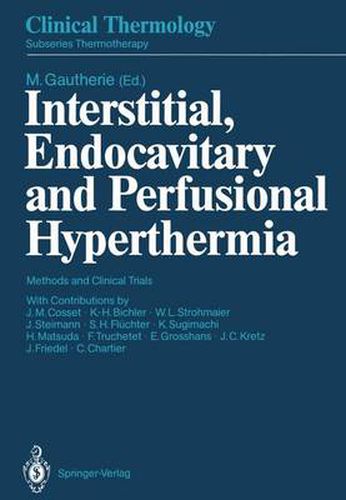Readings Newsletter
Become a Readings Member to make your shopping experience even easier.
Sign in or sign up for free!
You’re not far away from qualifying for FREE standard shipping within Australia
You’ve qualified for FREE standard shipping within Australia
The cart is loading…






Internal hyperthermia is a type of thermotherapy by which heat is sup plied to tumor tissue in situ. There are three different techniques for pro viding internal hyperthermia: (1) interstitial hyperthermia using implanted needle probes, (2) intracavitary hyperthermia using probes introduced into natural body cavities, and (3) perfusional hyperthermia by means of ex tracorporal blood heating. Compared with external hyperthermia, internal hyperthermia has been preferentially accepted by oncologists because it can be more easily combined with other forms of treatment, e. g., interstitial thermotherapy with brachytherapy, or perfusional hyperthermia with che motherapy. Various types of equipment for interstitial and intracavitary thermotherapy have been developed and used quite extensively in clinical trials, generally in combination with radiation therapy. There are four different methods for producing interstitial or intracavitary hyperthermia, each related to different types of heating. Most studies have been performed using radiofrequency electrodes (resistive heating) or coaxial microwave antennas (radiative heating). Recently, however, hot source techniques that rely on thermal conduction and blood flow convection for heat transport have found clinical application. These techniques include ferromagnetic implants activated by hot water or by electrical means. In the near future, new methods for in terstitial or intraluminal heating based upon advanced ultrasonic and laser technologies will be developed.
$9.00 standard shipping within Australia
FREE standard shipping within Australia for orders over $100.00
Express & International shipping calculated at checkout
Internal hyperthermia is a type of thermotherapy by which heat is sup plied to tumor tissue in situ. There are three different techniques for pro viding internal hyperthermia: (1) interstitial hyperthermia using implanted needle probes, (2) intracavitary hyperthermia using probes introduced into natural body cavities, and (3) perfusional hyperthermia by means of ex tracorporal blood heating. Compared with external hyperthermia, internal hyperthermia has been preferentially accepted by oncologists because it can be more easily combined with other forms of treatment, e. g., interstitial thermotherapy with brachytherapy, or perfusional hyperthermia with che motherapy. Various types of equipment for interstitial and intracavitary thermotherapy have been developed and used quite extensively in clinical trials, generally in combination with radiation therapy. There are four different methods for producing interstitial or intracavitary hyperthermia, each related to different types of heating. Most studies have been performed using radiofrequency electrodes (resistive heating) or coaxial microwave antennas (radiative heating). Recently, however, hot source techniques that rely on thermal conduction and blood flow convection for heat transport have found clinical application. These techniques include ferromagnetic implants activated by hot water or by electrical means. In the near future, new methods for in terstitial or intraluminal heating based upon advanced ultrasonic and laser technologies will be developed.